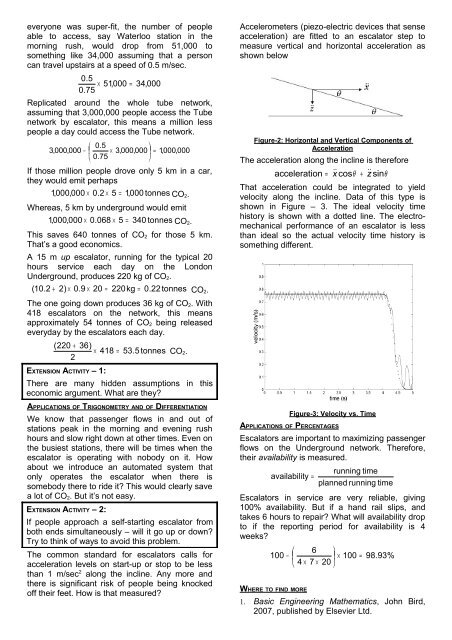The Mathematics of Escalators on the London ... - The Engineer
The Mathematics of Escalators on the London ... - The Engineer
The Mathematics of Escalators on the London ... - The Engineer
Create successful ePaper yourself
Turn your PDF publications into a flip-book with our unique Google optimized e-Paper software.
every<strong>on</strong>e was super-fit, <strong>the</strong> number <str<strong>on</strong>g>of</str<strong>on</strong>g> people<br />
able to access, say Waterloo stati<strong>on</strong> in <strong>the</strong><br />
morning rush, would drop from 51,000 to<br />
something like 34,000 assuming that a pers<strong>on</strong><br />
can travel upstairs at a speed <str<strong>on</strong>g>of</str<strong>on</strong>g> 0.5 m/sec.<br />
0.<br />
5<br />
×<br />
0.<br />
75<br />
51,<br />
000<br />
=<br />
34,<br />
000<br />
Replicated around <strong>the</strong> whole tube network,<br />
assuming that 3,000,000 people access <strong>the</strong> Tube<br />
network by escalator, this means a milli<strong>on</strong> less<br />
people a day could access <strong>the</strong> Tube network.<br />
⎛ 0.<br />
5<br />
⎞<br />
3 , 000,<br />
000 − ⎜ × 3,<br />
000,<br />
000 ⎟ =<br />
⎝ 0.<br />
75<br />
⎠<br />
1,<br />
000,<br />
000<br />
If those milli<strong>on</strong> people drove <strong>on</strong>ly 5 km in a car,<br />
<strong>the</strong>y would emit perhaps<br />
1 , 000,<br />
000 × 0.<br />
2 × 5 = 1,<br />
000 t<strong>on</strong>nes CO2.<br />
Whereas, 5 km by underground would emit<br />
1 , 000,<br />
000 × 0.<br />
068 × 5 = 340 t<strong>on</strong>nes CO2.<br />
This saves 640 t<strong>on</strong>nes <str<strong>on</strong>g>of</str<strong>on</strong>g> CO2 for those 5 km.<br />
That’s a good ec<strong>on</strong>omics.<br />
A 15 m up escalator, running for <strong>the</strong> typical 20<br />
hours service each day <strong>on</strong> <strong>the</strong> L<strong>on</strong>d<strong>on</strong><br />
Underground, produces 220 kg <str<strong>on</strong>g>of</str<strong>on</strong>g> CO2.<br />
( 10.<br />
2 + 2)<br />
× 0.<br />
9 × 20 ≈ 220kg<br />
= 0.<br />
22 t<strong>on</strong>nes CO2.<br />
<str<strong>on</strong>g>The</str<strong>on</strong>g> <strong>on</strong>e going down produces 36 kg <str<strong>on</strong>g>of</str<strong>on</strong>g> CO2. With<br />
418 escalators <strong>on</strong> <strong>the</strong> network, this means<br />
approximately 54 t<strong>on</strong>nes <str<strong>on</strong>g>of</str<strong>on</strong>g> CO2 being released<br />
everyday by <strong>the</strong> escalators each day.<br />
( 220 +<br />
2<br />
36)<br />
EXTENSION ACTIVITY – 1:<br />
× 418 =<br />
53.<br />
5 t<strong>on</strong>nes<br />
CO2.<br />
<str<strong>on</strong>g>The</str<strong>on</strong>g>re are many hidden assumpti<strong>on</strong>s in this<br />
ec<strong>on</strong>omic argument. What are <strong>the</strong>y?<br />
APPLICATIONS OF TRIGONOMETRY AND OF DIFFERENTIATION<br />
We know that passenger flows in and out <str<strong>on</strong>g>of</str<strong>on</strong>g><br />
stati<strong>on</strong>s peak in <strong>the</strong> morning and evening rush<br />
hours and slow right down at o<strong>the</strong>r times. Even <strong>on</strong><br />
<strong>the</strong> busiest stati<strong>on</strong>s, <strong>the</strong>re will be times when <strong>the</strong><br />
escalator is operating with nobody <strong>on</strong> it. How<br />
about we introduce an automated system that<br />
<strong>on</strong>ly operates <strong>the</strong> escalator when <strong>the</strong>re is<br />
somebody <strong>the</strong>re to ride it? This would clearly save<br />
a lot <str<strong>on</strong>g>of</str<strong>on</strong>g> CO2. But it’s not easy.<br />
EXTENSION ACTIVITY – 2:<br />
If people approach a self-starting escalator from<br />
both ends simultaneously – will it go up or down?<br />
Try to think <str<strong>on</strong>g>of</str<strong>on</strong>g> ways to avoid this problem.<br />
<str<strong>on</strong>g>The</str<strong>on</strong>g> comm<strong>on</strong> standard for escalators calls for<br />
accelerati<strong>on</strong> levels <strong>on</strong> start-up or stop to be less<br />
than 1 m/sec 2 al<strong>on</strong>g <strong>the</strong> incline. Any more and<br />
<strong>the</strong>re is significant risk <str<strong>on</strong>g>of</str<strong>on</strong>g> people being knocked<br />
<str<strong>on</strong>g>of</str<strong>on</strong>g>f <strong>the</strong>ir feet. How is that measured?<br />
Accelerometers (piezo-electric devices that sense<br />
accelerati<strong>on</strong>) are fitted to an escalator step to<br />
measure vertical and horiz<strong>on</strong>tal accelerati<strong>on</strong> as<br />
shown below<br />
Figure-2: Horiz<strong>on</strong>tal and Vertical Comp<strong>on</strong>ents <str<strong>on</strong>g>of</str<strong>on</strong>g><br />
Accelerati<strong>on</strong><br />
<str<strong>on</strong>g>The</str<strong>on</strong>g> accelerati<strong>on</strong> al<strong>on</strong>g <strong>the</strong> incline is <strong>the</strong>refore<br />
accelerati<strong>on</strong> = x˙<br />
˙ cosθ<br />
+ z˙<br />
˙ sinθ<br />
That accelerati<strong>on</strong> could be integrated to yield<br />
velocity al<strong>on</strong>g <strong>the</strong> incline. Data <str<strong>on</strong>g>of</str<strong>on</strong>g> this type is<br />
shown in Figure – 3. <str<strong>on</strong>g>The</str<strong>on</strong>g> ideal velocity time<br />
history is shown with a dotted line. <str<strong>on</strong>g>The</str<strong>on</strong>g> electromechanical<br />
performance <str<strong>on</strong>g>of</str<strong>on</strong>g> an escalator is less<br />
than ideal so <strong>the</strong> actual velocity time history is<br />
something different.<br />
Figure-3: Velocity vs. Time<br />
APPLICATIONS OF PERCENTAGES<br />
<str<strong>on</strong>g>Escalators</str<strong>on</strong>g> are important to maximizing passenger<br />
flows <strong>on</strong> <strong>the</strong> Underground network. <str<strong>on</strong>g>The</str<strong>on</strong>g>refore,<br />
<strong>the</strong>ir availability is measured.<br />
availabili ty =<br />
running time<br />
planned running time<br />
<str<strong>on</strong>g>Escalators</str<strong>on</strong>g> in service are very reliable, giving<br />
100% availability. But if a hand rail slips, and<br />
takes 6 hours to repair? What will availability drop<br />
to if <strong>the</strong> reporting period for availability is 4<br />
weeks?<br />
⎛ 6 ⎞<br />
100 − ⎜<br />
⎟ × 100 =<br />
⎝ 4 × 7 × 20 ⎠<br />
WHERE TO FIND MORE<br />
98.<br />
93%<br />
1. Basic <strong>Engineer</strong>ing <str<strong>on</strong>g>Ma<strong>the</strong>matics</str<strong>on</strong>g>, John Bird,<br />
2007, published by Elsevier Ltd.


